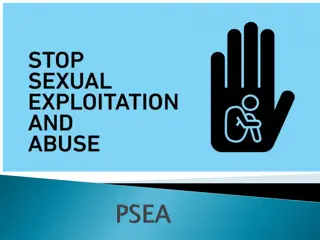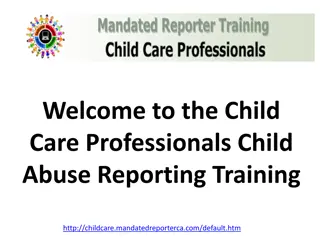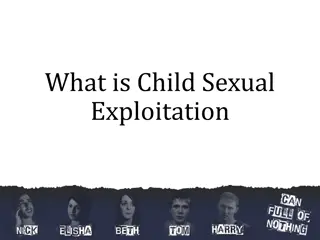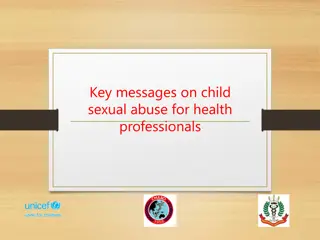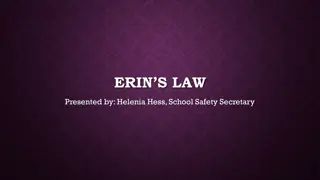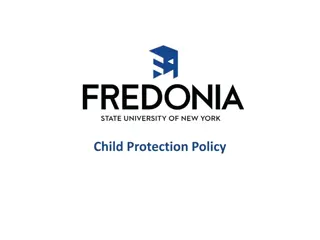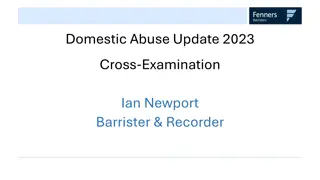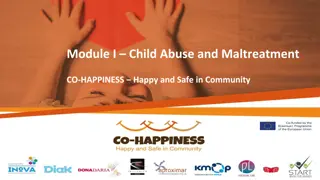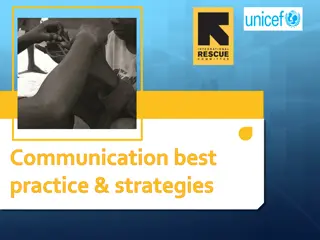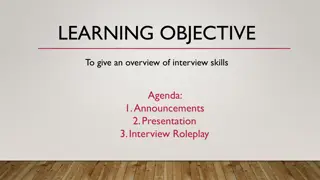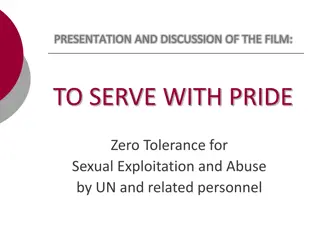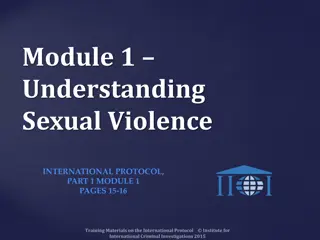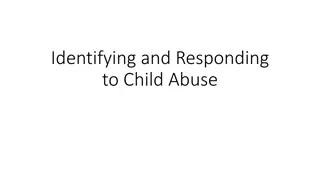Methods to Interview Child with Sexual Abuse - Insights from Dr. Manju Mehta, AIIMS
Explore effective methods to interview children who may have experienced sexual abuse, as shared by Dr. Manju Mehta, a former Professor of Clinical Psychology at AIIMS, New Delhi. Learn about challenges in rapport building, communication, and time factors, along with observing signs of abuse and conducting interviews with the child and their parents/caretakers. Understand different types of sexual abuse and characteristics of abuse to help identify and address such sensitive issues.
Download Presentation

Please find below an Image/Link to download the presentation.
The content on the website is provided AS IS for your information and personal use only. It may not be sold, licensed, or shared on other websites without obtaining consent from the author.If you encounter any issues during the download, it is possible that the publisher has removed the file from their server.
You are allowed to download the files provided on this website for personal or commercial use, subject to the condition that they are used lawfully. All files are the property of their respective owners.
The content on the website is provided AS IS for your information and personal use only. It may not be sold, licensed, or shared on other websites without obtaining consent from the author.
E N D
Presentation Transcript
Methods to Interview Child with Sexual Abuse Dr. Manju Mehta, Former Prof. of Clinical Psychology, AIIMS, New-Delhi drmanju.mehta@gmail.com
Challenges Rapport building Communication Time Factor Informants Setting Infrastructure : Child Friendly
Methods Observation Interview Drawings/ Play Questionnaires
Observation : Recognize the signs The signs of abuse not obvious, and learning the warning signs of child sexual abuse could be life saving. Behavioral signs: Shrinking away from or seeming threatened by physical contact, regressive behaviors like thumb sucking, changing hygiene routines such as refusing to bathe or bathing excessively, age-inappropriate sexual behaviors, sleep disturbances, or nightmares Verbal cues: Using words or phrases that are too adult for their age, unexplained silence, or suddenly being less talkative Physical signs: Bruising or swelling near the genital area, blood on sheets or undergarments, or broken bones
Interview With the Child With Parents/ caretaker
Type of Sexual Abuse 1. Sexual Talk - Did someone talk about sex to you, in front of you, write a sexual thing about you in such a way that it made you uncomfortable? 2. Exposure/Voyeurism - Did anyone make you watch a sex video? Make you look at sexual picture in a magazine? Make you show their private parts? Show their private parts to you?
3. Fondle outside clothing? 4. Fondle under clothing ? 5. Oral Sex/Genital/ Anal penetration (Tried to force you into sexual activities) 6. Pornography/Prostitution/ Exploitation (Make a sex video of you alone or with other people doing things)
II. Characteristics of Abuse What happened ? What was your initial reaction? In what way do you think it affected you?
III. Characteristics of the Abuse Situation Age of Onset Age at the end of abuse Duration (Number of days) Number of times (In a day, week or month) Frequency (Once, Many) Use of Force (Absent or present) Threats regarding disclosure
IV. Suspect-Victim Relation Out of house, unrelated Out of house, related In house child/teen In-house unrelated In house, grandparents, aunt, uncle or cousin In house father, stepfather, adoptive father, foster father In house mother, stepmother, adoptive mother, foster mother Duration for which the perpetuator knew the child:
V. Victim Age VI. Number of Victims VII. Number of Perpetuator VIII. Functioning of the Non-offending Parent -Reaction to knowledge about the sexual abuse - Support given to the victim
IX. Response of Suspect Admits and takes responsibility Admits but does not accept responsibility Denies Denies and blames victim X. Other Individual and Family Problem Substance Abuse, violence, mental retardation and mental illness
XI. Childs Experience Feeling after abuse: Shame/guilt Fear/frustration Any other (Specify) What did you do following abuse Keep quite Felt guilty Avoided meeting the person
What was your parents reaction when you disclosed? Why did you not reveal it to anyone ? Does it still bother you? Who supported you? How you feel towards that person?
Guidelines- Talk to the child Create a non-threatening environment where the child may be more likely to open up Pick time and place carefully. Choose a space where the child is comfortable or ask them where they d like to talk. Be aware of your tone. serious tone - may scare the child, make the conversation more casual. A non-threatening tone will help put the child at ease and ultimately provide with more accurate information.
Interview Talk to the child directly. Ask questions that use the child s own vocabulary, but that are a little vague. For example, Has someone been touching you? Use words familiar to the child No one touches me except my mom at bath time, or You mean like the way my cousin touches me sometimes Listen and follow up. Allow the child to talk freely. Wait for them to pause, and then follow up on points that made you feel concerned.
Avoid judgment and blame. You said something that made me worry consider starting your conversation with the word I. For example: I am concerned because I heard you say that you are not allowed to sleep in your bed by yourself. Reassure the child. Let the child know you are simply asking questions out of concern Be patient. may be very frightening for the child. Many perpetrators make threats about what will happen if someone finds out about the abuse.
Questioning Make sure no harm is done to a traumatized child. No harm to any investigation Imagine being a child who is being asked to describe in detail a sexual crime to strangers Parents who suspect their child has been abused do not always ask their child direct questions for fear they may hurt them further.
Drawing/ Play Drawing Human figure Play with toys representing different persons in child`s life Enacting the situation and response through projection
Questionnaire 1. Child Sexual Behavior Inventory (Friedrich et al. 2001) 2. Children s Impact of Traumatic Events Scale (Wolfe and Gentile)
Understanding the case First, an interviewer must know the details of how the abuse came to be suspected. Look specifically at whether the child chose to report or if the disclosure was accidental.
Respect the child Put at ease, let them know the Judge is a parent, husband/wife, brother/sister. Explain they care very much about children. Use self-disclosure. Research shows that to do some self-disclosure helps another person become comfortable with his or her own self-disclosure. Try to share some neutral issues that demonstrate things you have in common with the child that you had a pet, that you have kids,
Private interview Talk to the child away from the parent if the child is comfortable with the separation. For young children say something like, Would you like to show your mom/dad where you want them to sit while you and I talk for a few minutes? Assume the parent does not know everything about their child s experience on the topic of suspected abuse. One thing a child may hide from their parent is that they may have enjoyed parts of the sexual experience, or some aspects of the relationship they had with that person. Interviewing the child s therapist may help understand these issues.
Child Communication Habits Adapt with the way child communicates Find out what a child calls certain parts of the body. Very general line drawings are available so that you can point to body parts and ask, What does your family call this? The examination will go more smoothly if all parties concerned use the child s vocabulary
Build Rapport Spend time to build a rapport. before getting to more difficult issues ,sensitive topic Do in a meeting prior to the trial. Ask a child about pets or their best friend. For a teen, ask about a favourite video or computer game, who they text the most often or what they most enjoy doing when they are with their friends.
Ask Neutral Questions Begin direct examination with very general questions that potentially bring spontaneous information. A short series of questions that works well is: Who is the nicest child you know? Who is the nicest grown-up you know? Who is the meanest child you know? Who is the meanest grown-up you know?
To Sum up Aim Focus Fact Finding Creditability assessment Multidisciplinary team Techniques Rapport building Obtaining details of the abuse
Rapport Development Ask simple questions Empathize with child`s feeling Use open ended questions Avoid anxiety arousing questions in the beginning Free recall Self expression period
4W1H Who When Where What How Informal setting Use drawing and play



